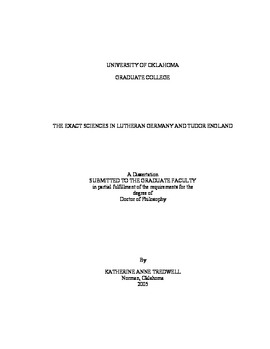| dc.contributor.advisor | Barker, Peter, | en_US |
| dc.contributor.author | Tredwell, Katherine Anne. | en_US |
| dc.date.accessioned | 2013-08-16T12:19:48Z | |
| dc.date.available | 2013-08-16T12:19:48Z | |
| dc.date.issued | 2005 | en_US |
| dc.identifier.uri | https://hdl.handle.net/11244/863 | |
| dc.description.abstract | The final chapters shift focus to England, where a revival of mathematical education was underway by mid-century. In this section, astronomy is defined broadly to include astronomical navigation, since the potential economic and political benefits of undertaking voyages of discovery provided part of the justification for mathematical studies. Elizabethan authors frequently cited and even translated Lutheran works, suggesting that Lutheran influence played an important role in the English mathematical renaissance. Most readers turned to Lutheran sources for technical guidance, in part because Melanchthon's followers had produced the leading works on Copernican astronomy. A smaller group, including some of the leading Tudor mathematicians, also adopted Melanchthon's providential reading of astronomy. Thus, English mathematical practitioners were not intellectually isolated, but form part of a continuous tradition that began in Wittenberg. | en_US |
| dc.description.abstract | This dissertation compares the astronomical works of two sets of writers in the sixteenth century: university professors in Lutheran territories, and mathematical practitioners and popularizers in Tudor England. The opening chapters establish the intellectual and institutional context by summarizing the development of the western astronomical tradition, including the place of mathematics in the university. Special attention is given to three problems in astronomy and the solutions proposed by Claudius Ptolemy and Nicolaus Copernicus: the prediction of the apparent motion of the Sun; the correct arrangement of stars and planets; and the measurement of the distances from Earth to the Sun, Moon, and other celestial objects. The educational reforms of Philip Melanchthon, who believed that divine providence manifested itself especially clearly in astronomy, ensured that Wittenberg and other Lutheran universities produced a number of highly competent and creative astronomers. | en_US |
| dc.description.abstract | The next two chapters examine the early responses to Copernicus at Wittenberg and the ongoing efforts among Melanchthon's followers to incorporate Copernican astronomy into the curriculum. Lutheran mathematicians agreed that Copernican models were superior in some respects to existing astronomical models, but most looked for ways to convert his controversial heliocentric cosmology to a geocentric framework. Both the geocentric majority and the tiny group of heliocentrists expected that a complete course of astronomical studies would include both Ptolemaic and Copernican models. | en_US |
| dc.format.extent | xii, 340 leaves : | en_US |
| dc.subject | Astronomy Mathematics. | en_US |
| dc.subject | Mathematics Study and teaching England. | en_US |
| dc.subject | Astronomy Germany. | en_US |
| dc.subject | Great Britain Intellectual life 16th century. | en_US |
| dc.subject | History, European. | en_US |
| dc.subject | Astronomy Early works to 1800. | en_US |
| dc.subject | History of Science. | en_US |
| dc.title | The exact sciences in Lutheran Germany and Tudor England. | en_US |
| dc.type | Thesis | en_US |
| dc.thesis.degree | Ph.D. | en_US |
| dc.thesis.degreeDiscipline | Department of History of Science | en_US |
| dc.note | Source: Dissertation Abstracts International, Volume: 66-02, Section: A, page: 0737. | en_US |
| dc.note | Adviser: Peter Barker. | en_US |
| ou.identifier | (UMI)AAI3163319 | en_US |
| ou.group | College of Arts and Sciences::Department of History of Science | |
